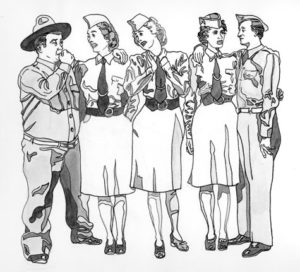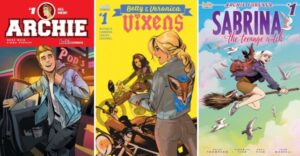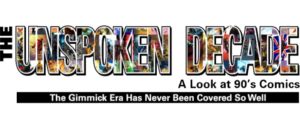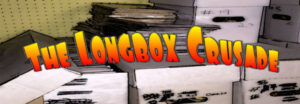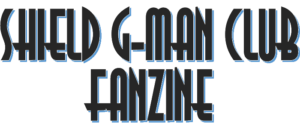HEMBECK, FROM FAN TO FAN FAVORITE
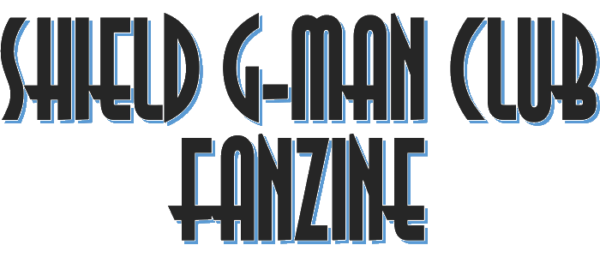
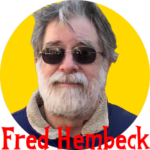 I have always been a fan of Fred Hembeck. Fred and I worked at the Comic Buyer’s Guide at the same time in the 90s. We share a birthday and exchange pleasantries on Facebook. But I have never had the opportunity before now to sit down with Fred and chat about his career.
I have always been a fan of Fred Hembeck. Fred and I worked at the Comic Buyer’s Guide at the same time in the 90s. We share a birthday and exchange pleasantries on Facebook. But I have never had the opportunity before now to sit down with Fred and chat about his career.
Shield G-Man Club: How old were you when you discovered comics?
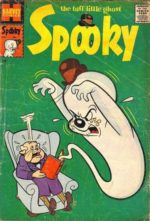 Fred Hembeck: Yes, about six years old, maybe seven. My dad came home with a conic from where he worked because the guy who worked with him had a son who was getting older and he didn’t care for them anymore. My first comic was a Spooky, The Tough Little Ghost. And so, I went to see if I liked it or not. And I liked it a lot. They were ninety-nine percent, Harvey and Dell. There was one Jimmy Olsen and one World’s Finest, but everything else was like kiddie comics. Well, you know, by 1961 when I was eight years old, that’s when I first started buying my own comics, from the stands, and that’s when I started buying the Superman comics, as my friends at school had impressed me with the Bizarro. Bizarro is what started it off. Also, those crazy comics where Superman would have like a large head because he’s from the future or something.
Fred Hembeck: Yes, about six years old, maybe seven. My dad came home with a conic from where he worked because the guy who worked with him had a son who was getting older and he didn’t care for them anymore. My first comic was a Spooky, The Tough Little Ghost. And so, I went to see if I liked it or not. And I liked it a lot. They were ninety-nine percent, Harvey and Dell. There was one Jimmy Olsen and one World’s Finest, but everything else was like kiddie comics. Well, you know, by 1961 when I was eight years old, that’s when I first started buying my own comics, from the stands, and that’s when I started buying the Superman comics, as my friends at school had impressed me with the Bizarro. Bizarro is what started it off. Also, those crazy comics where Superman would have like a large head because he’s from the future or something.
SGMC: When did you start drawing comics (not professionally but as a kid)?
Fred: As a kid, I had been drawing pretty much since I was in kindergarten. I remember tracing over Superman from one of the DC Comics. That was an early inspiration.
SGMC: Where did you go to art school?
Fred: I went to two schools for two years. I went to a two-year local State University of New York at Farmingdale, and they had an art course there, the same course taken by Len Wein several years earlier. Then I transferred to the State University at Buffalo. That was getting out of the house. I was at home for the first two years. and then I moved to Buffalo, which is very far from Long Island and I could not drive there each day.
SGMC: When did you go to your first convention?
Fred: I don’t remember the exact year, but it was a couple of years before it started in the business. I was in college. It was one of those Phil Seuling Conventions, one the big ones. I remember me and my friend going there.
SGMC: What was your first comic con portfolio review like?
Fred: Not good. They never were. I put my stuff in a portfolio, I was living in my parents home, I took the train into New York City, showed my stuff around the DC office and they want me to leave it overnight. So, I left it overnight. I have no idea what they had to say about it. But when I took it to DC Comics then and I got an audience with Mr. Collette and he was not at all happy with the work I came up with.
SGMC: How did you develop your more quirky style?
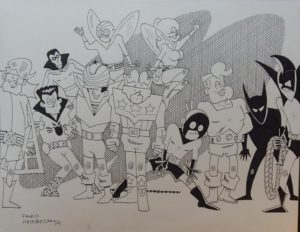 Fred: That’s not what I was showing. It’s just regular stuff I showed. It’s just kind of developed out of the fact that I got turned down and I needed to keep myself going. I was going to get a second portfolio together. And I was going to show everybody how great it was. But in the meantime, I should do something. I wanted to do this little strip here and “I’ll send it into the Comic Buyer’s Guide and, who knows what’s going to happen?” I never did do that second portfolio, things kind of fell into place after that. Oddly enough, if I’d managed to do the work and get the job at DC, I would have been like one mediocre guy who people would have forgotten about very soon after doing like three or four issues. So, I kind of worked out for the best.
Fred: That’s not what I was showing. It’s just regular stuff I showed. It’s just kind of developed out of the fact that I got turned down and I needed to keep myself going. I was going to get a second portfolio together. And I was going to show everybody how great it was. But in the meantime, I should do something. I wanted to do this little strip here and “I’ll send it into the Comic Buyer’s Guide and, who knows what’s going to happen?” I never did do that second portfolio, things kind of fell into place after that. Oddly enough, if I’d managed to do the work and get the job at DC, I would have been like one mediocre guy who people would have forgotten about very soon after doing like three or four issues. So, I kind of worked out for the best.
SGMC: How did you get involved in fanzines?
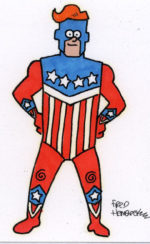 Fred: Oh, I love fanzines. I started getting them in 1967. I saw that advertisement in a comic book for Castle of Frankenstein Magazine and I sent away for some of this stuff and it was just really good. At that point in my life, mid-teens, the friends of mine who had read comics had all bailed. They bailed by the time we got to seventh grade, but I didn’t bail. So, it’s nice to have evidence that there are other people, my age or even older who are interested in these things. For a while, about 1967 or 1968 I was probably more interested in the fanzines than I was in the actual comic book’s that were coming out. I would send a couple of drawings in, but never to the really big fanzines that people know about. Some things were published, you know, in a different style. Not the style I have now.
Fred: Oh, I love fanzines. I started getting them in 1967. I saw that advertisement in a comic book for Castle of Frankenstein Magazine and I sent away for some of this stuff and it was just really good. At that point in my life, mid-teens, the friends of mine who had read comics had all bailed. They bailed by the time we got to seventh grade, but I didn’t bail. So, it’s nice to have evidence that there are other people, my age or even older who are interested in these things. For a while, about 1967 or 1968 I was probably more interested in the fanzines than I was in the actual comic book’s that were coming out. I would send a couple of drawings in, but never to the really big fanzines that people know about. Some things were published, you know, in a different style. Not the style I have now.
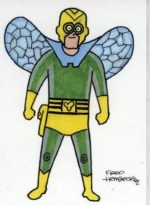 SGMC: How did you end up at Eclipse Comics?
SGMC: How did you end up at Eclipse Comics?
Fred: That was because I was friends with Richard Bruning at the time. We’d been corresponding quite a bit and he was friends with Dean Mullaney and they had their first publication. It was Sabre, I believe, by Don McGregor and Paul Gulacy. They were late for a follow-up. It was slow in coming out. Richard said to Dean, “Hey, you know, why don’t you collect a bunch of these Dateline:@#$% strips?” It’s like you got like a premade magazine. You’ll have your second publication. That’s pretty much what happened. But then they were slow and getting the second Dateline:@#$% done. So, I’ve moved near Albany, New York and I’m shopping at FantaCo comic book store there. They talked about they wanted to get into some publishing. I had the second magazine already done and Eclipse wasn’t getting around to it, I said, “Hey, do you mind if I do this with the FantaCo?” They said, “Go right ahead.” At the time I was naive to think they were happy with me leaving, but I don’t know. Years later, when they had the history of Eclipse, somehow, I was not involved.
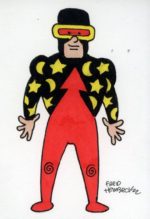 SGMC: How were you able to make the transition to DC Comics?
SGMC: How were you able to make the transition to DC Comics?
Fred: Well, it was you know, after I got the thing going in the Comic Buyers’ Guide for a while and I’d had the first collection published by Eclipse with my name on the Big Title of the collection. I got a call one day, I believe from Barbara Zakin, but it could’ve been Mike Gold, Tony Tolin or Todd Kline. The four of them were thinking about Direct Currents, it was kind of like a newspaper and newspaper should have a comic strip. Who should do the comic strip? “Hey, there’s this guy Fred Hembeck. I like his gags, Let’s call him up and see if he wants to do it.” And they call me up and I said, “Sure”. I said, “Well, what should we call it?” They said “I don’t know what you want do call it? Let’s use your name, it’s kind of an unusual name.” That’s kind of how that all came about. It kept going until the DC Comics Implosion. They felt the need to add more pages to their comics, so, the Direct Currents page was shoved over to them once a month as DC Dollar Comic and then eventually that went away. So that was the end of my time at DC. It was fun while it lasted.
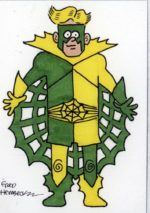 SGMC: How did you break into Marvel?
SGMC: How did you break into Marvel?
Fred: Jim Salicrup like my stuff. He was working on Marvel Age Magazine and he got me to do it. That was before the Fantastic Four Roast.
SGMC: How did the Fantastic Four Roast come about?
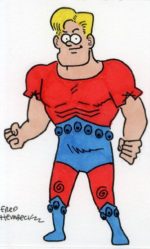 Fred: Jim Shooter, who I met at a convention a few months earlier remembered but I’d forgotten this, I had sent him an illustrated letter praising his work on The Avengers. I ran into him again at a Creation Convention and he started talking and me and told me what plan he had going on and he was happy to see me. He said “You know, we’re going to be doing all kinds of different comics at Marvel under my tutelage and we may even do a Fred Hembeck Comic, and I’m thinking myself. “Yeah. Like that’s ever going to happen.” But I’m smiling and everything. Years later, Jim Shooster posted that illustrated letter I wrote to him online and that’s when I saw it. and thought “Oh, no wonder he liked me and was so nice to me that day”. The 20th Anniversary of the Fantastic Four was coming up and he called me up one day, this was a year or two after my initial meeting with him and he said that he wanted to do this roast idea and he had another writer in mind, but it didn’t seem like what they were doing. He didn’t have a feel for it and would I like to do it, of course, I said, “Yes, sure I would”
Fred: Jim Shooter, who I met at a convention a few months earlier remembered but I’d forgotten this, I had sent him an illustrated letter praising his work on The Avengers. I ran into him again at a Creation Convention and he started talking and me and told me what plan he had going on and he was happy to see me. He said “You know, we’re going to be doing all kinds of different comics at Marvel under my tutelage and we may even do a Fred Hembeck Comic, and I’m thinking myself. “Yeah. Like that’s ever going to happen.” But I’m smiling and everything. Years later, Jim Shooster posted that illustrated letter I wrote to him online and that’s when I saw it. and thought “Oh, no wonder he liked me and was so nice to me that day”. The 20th Anniversary of the Fantastic Four was coming up and he called me up one day, this was a year or two after my initial meeting with him and he said that he wanted to do this roast idea and he had another writer in mind, but it didn’t seem like what they were doing. He didn’t have a feel for it and would I like to do it, of course, I said, “Yes, sure I would” 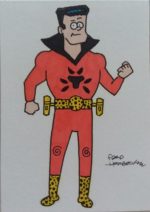 and so that’s how that came about. Well, I just read recently that the Marvel was putting together a hardcover, Marvel Masterworks: The Fantastic Four Vol. 21, the latest one with the John Byrne and they included the Fantastic Four Roast. So, if I was permanently in the Marvel canon, so to speak. It’s pretty cool. I mean, they could send me a free copy, which is would be nice, too.
and so that’s how that came about. Well, I just read recently that the Marvel was putting together a hardcover, Marvel Masterworks: The Fantastic Four Vol. 21, the latest one with the John Byrne and they included the Fantastic Four Roast. So, if I was permanently in the Marvel canon, so to speak. It’s pretty cool. I mean, they could send me a free copy, which is would be nice, too.
SGMC: What made you want to Destroy the Marvel Universe?
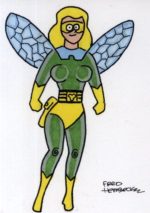 Fred: That was another thing that Jim called up and said “You know, there’s this whole big thing going on and the Buyers Guide with Cat Yronwode saying, I’m going to destroy all the characters and it’s going to be a mess. Why don’t we do something that satirizes that? Jim Shooter Destroys the Marvel Universe?” He called me back and said, “You know, I talked to the people, the business people, and they didn’t like the idea of my name being in the title, let’s look, put your name in the title.” And I’m thinking, “Well, no, I would be too modest for that.” Of course, it didn’t take much convincing for me to say. “OK. We’ll do that.” I got my name in the history books, so to speak.
Fred: That was another thing that Jim called up and said “You know, there’s this whole big thing going on and the Buyers Guide with Cat Yronwode saying, I’m going to destroy all the characters and it’s going to be a mess. Why don’t we do something that satirizes that? Jim Shooter Destroys the Marvel Universe?” He called me back and said, “You know, I talked to the people, the business people, and they didn’t like the idea of my name being in the title, let’s look, put your name in the title.” And I’m thinking, “Well, no, I would be too modest for that.” Of course, it didn’t take much convincing for me to say. “OK. We’ll do that.” I got my name in the history books, so to speak.
SGMC: You have done a lot of art with the Mighty Crusaders. When did you first discover the Mighty Crusaders?
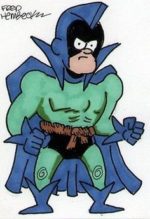 Fred: Before the Mighty Crusaders, there was the Fly. I discovered it after Superman comics, and before I even read a Marvel superhero comic, I was buying the Archie Adventure series with the Fly and the Jaguar. The John Rosenberg era. I didn’t see the Kirby stuff. I was always finding new superheroes and one day The Fly became Fly-Man and John Rosenberger became Paul Reinman. I kept buying it and then they started sneaking new heroes in and it became the Mighty Crusaders. Now, you know, I love the idea. Going back to the Justice Society of America, the heroes of the 40s and Captain America. So, when they brought these characters back and said that they’re from the Golden Age, I was really excited. There was one of the books I enjoy, especially that one issue called “Too Many Heroes”. It’s had like 40 different characters, it was almost everybody they ever published in the 40s in one story. I like that stuff. Although, you know, to be honest, I was never a big fan of Paul Reinman’s artwork and the stories are kind of goofy, but I always liked the characters.
Fred: Before the Mighty Crusaders, there was the Fly. I discovered it after Superman comics, and before I even read a Marvel superhero comic, I was buying the Archie Adventure series with the Fly and the Jaguar. The John Rosenberg era. I didn’t see the Kirby stuff. I was always finding new superheroes and one day The Fly became Fly-Man and John Rosenberger became Paul Reinman. I kept buying it and then they started sneaking new heroes in and it became the Mighty Crusaders. Now, you know, I love the idea. Going back to the Justice Society of America, the heroes of the 40s and Captain America. So, when they brought these characters back and said that they’re from the Golden Age, I was really excited. There was one of the books I enjoy, especially that one issue called “Too Many Heroes”. It’s had like 40 different characters, it was almost everybody they ever published in the 40s in one story. I like that stuff. Although, you know, to be honest, I was never a big fan of Paul Reinman’s artwork and the stories are kind of goofy, but I always liked the characters.
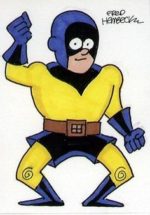 SGMC: What did you think of their quirkiness of the Crusaders in the 60s?
SGMC: What did you think of their quirkiness of the Crusaders in the 60s?
Fred: Well, at the time, it was a weird combination of Stan Lee’s writing mixed with Batman TV show camp. A little of that goes a long way. But I read them, It was fun. I always like those kinds of quirky books, like, Harvey’s Thrill-O-Rama, Comics and T.H.U.N.D.E.R. Agents, all that stuff to give me a little break from the usual Marvel and DC. If someone was wearing a costume, I was buying it.
SGMC: You do a lot of comic cover recreations; how do you choose which covers to recreate?
Fred: Well, of course, sometimes specific requests well not requested, people pay for it, not just requested it.
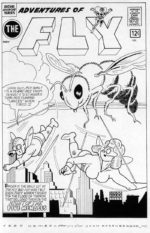 The first few of them, I would dig out something important to me that I enjoyed. The old Marvel stuff from the early 60s. That is why when I was doing the Buyer’s Guide in the 90s, I would do two, three or four different covers that maybe had a theme. I would go down to my Staples store and I would reduce the covers and then I pasted them up and wrote a little something and turned it into a strip. Then I would sell each one of covers on eBay. So, it kind of worked out that way. But I should point out, I’m sick of doing covers. I’m not doing them anymore. It’s funny, you guys wrote to me about commissions because I kind of put them aside a few months ago. I said to myself, “I have several, I still do that are hanging over my head that I’m trying to get finished.” I’m not going to take on any more for the time being, because I’d just rather finish up what I have. I’d like to just draw what I like to drawn and put it up on eBay and see what happens. So that kind of works out for me. So right now, I’m not taking on any commissions unless, you know, somebody says my daughter would like a Spider-Man card for her birthday. As opposed to someone would want me to do 12 characters for Mortal Kombat all on a 9×12 drawing? No, I don’t think I’ll be doing that today. So, I’m done with that kind of stuff.
The first few of them, I would dig out something important to me that I enjoyed. The old Marvel stuff from the early 60s. That is why when I was doing the Buyer’s Guide in the 90s, I would do two, three or four different covers that maybe had a theme. I would go down to my Staples store and I would reduce the covers and then I pasted them up and wrote a little something and turned it into a strip. Then I would sell each one of covers on eBay. So, it kind of worked out that way. But I should point out, I’m sick of doing covers. I’m not doing them anymore. It’s funny, you guys wrote to me about commissions because I kind of put them aside a few months ago. I said to myself, “I have several, I still do that are hanging over my head that I’m trying to get finished.” I’m not going to take on any more for the time being, because I’d just rather finish up what I have. I’d like to just draw what I like to drawn and put it up on eBay and see what happens. So that kind of works out for me. So right now, I’m not taking on any commissions unless, you know, somebody says my daughter would like a Spider-Man card for her birthday. As opposed to someone would want me to do 12 characters for Mortal Kombat all on a 9×12 drawing? No, I don’t think I’ll be doing that today. So, I’m done with that kind of stuff.
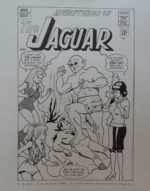 SGMC: Are you still doing the sketch cards?
SGMC: Are you still doing the sketch cards?
Fred: Oh, I love the sketch cards. I love to do the sketch cards. I love to look for new stuff. Who knew that would become a thing. Someone suggested I do one, and I have been doing them ever since.
SGMC: What do you charge for sketch cards?
Fred: It varies depending on the character, but usually between $15 and $20 for a character. One guy ordered 50 of them and another ordered 25, that’s the kind of thing at hangs over my head. So now just I might do it, but only a few at a time.
SGMC: What would you tell a young artist who wants to break into comics today?
Fred: Don’t do what I did. I don’t know how I ever got into comics. People say tell us how to get to comics. I’m saying, well, if you followed my round, good luck. It’s very peculiar. And I wouldn’t expect lightning to strike twice. But I guess the thing to do is to like keep drawing as much as you can try to get noticed. I mean, wow. I don’t know if I could get noticed now with so many outlets online and stuff. But back when I was doing what I was doing there wasn’t that many of us. Just keep trying. That’s all I can say.

